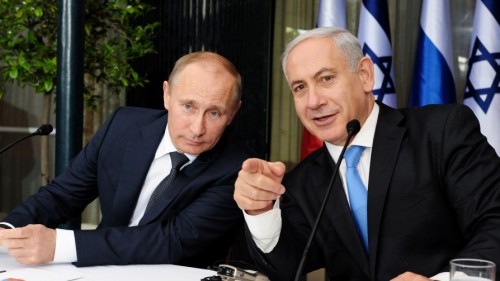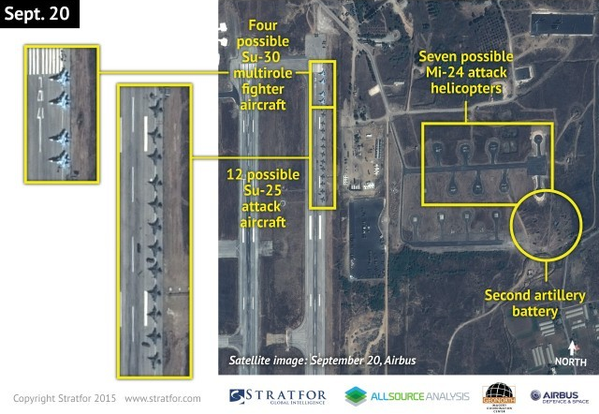PHOTO: Russian President Vladimir Putin and Israeli Prime Minister Benjamin Netanyahu in Moscow on Monday
LATEST
- Lebanon to Provide Schooling for Up to 100,000 More Syrian Refugee Children
- Rumors Swirl Over “2nd Group of US-Trained Fighters” in Northern Syria
TUESDAY FEATURE
UPDATE 1415 GMT: Russia’s Deputy Foreign Minister has praised the US for a “more realistic approach” to the Syrian conflict.
Gennady Gatilov said on Tuesday:
It seems that our partners have taken a more realistic approach to certain things. At first, they stuck to a thesis that Bashar al-Assad should go and nothing could be done so long as he stays in power.
The thesis [about Assad’s departure] remains in the US strategic plans, but in terms of tactics the US is trying to find some steps that would allow tasking a different look at prospects for a political settlement and starting a political dialogue among the conflicting parties in Syria.
However, Gatilov criticized the US and other countries for their blame of the Assad regime for Syria’s more than 4 million refugees. Instead, the Deputy Foreign Minister focused on the Islamic State, the stated reason for Russia’s escalating military intervention in Syria:
We have been saying right from the start that the conflict situation fomented by Western partners in the region of Middle East and North Africa could have such consequences, and it has happened.
Attempts to say that all this is happening because of the policy Assad pursues in his country are inconsistent. People are fleeing a war and the activity of Islamic State.
Russia has brought more warplanes into its expanding airbase in western Syria, while appearing to secure the acceptance of other powers of its actions.
US officials say that there are now 28 aircraft at the base in Latakia Province, including a dozen Su-24 and a dozen Su-25 ground-attack planes which arrived over the weekend. Video and photographs also appear to show that Su-30s, advanced jets for both attack and communications, are now at the base.
Fifteen Russian Hip transport and Hind attack helicopters are also present. The aircraft are protected by at least two or possibly three SA-22 surface-to-air, antiaircraft systems.
US officials also said on Tuesday that Russian surveillance drones are now carrying out reconnaissance over Syria, possibly establishing targets for attacks by either Syrian or Russian pilots.
(Image: Stratfor)
US objections to the build-up appear to have evaporated. On Sunday, US Secretary of State John Kerry and German Foreign Minister Frank-Walter Steinmeier put the emphasis on getting Russia to convince President Assad to accept negotiations for a political resolution. Yesterday Washington said that there would be no further military-to-military discussions over Moscow’s actions.
Secretary of Defense Ashton Carter called his Russian counterpart Sergei Shoygu last Friday to discuss how to avoid accidental clashes in operations over Syria, where a US-led coalition is also carrying out attacks on the Islamic State and the Islamist faction Jabhat al-Nusra.
“At this point, this is a diplomatic issue,” a US official said.
The State Department did indicate on Monday that Russia should ensure that its military expansion is directed against the Islamic State — Moscow’s declared objective for the deployments. “If what they’re doing is, in fact, propping up the Assad regime,” said spokesman John Kirby, “then that’s an entirely different issue altogether, because it is the Assad regime that has been a magnet for extremists inside Syria.”
Appearing to contradict Moscow’s Islamic State-centered rhetoric, American sources also that 500 additional Russian troops have arrived in Syria this month, as well as nine advanced T-90 tanks.
Pro-regime outlets have said that about 850 troops have deployed as “advisors” in northeast Latakia Province, near a key battlefront with rebels; in Tartous Province on the Mediterranean; and in Homs Province to the east.
Leith Abou Fadel, who runs the pro-regime Al-Masdar News, said on Monday that 450 Russian Marines at the Syrian Special Forces Headquarters in Slunfeh in northeast Latakia Province. Others are directing Assad militia in Hama Province and “overseeing the [Syrian Army’s] battle in Palmyra” against the Islamic State.
Moscow’s Diplomatic Victory with Israel
Russia gained more acceptance of its military steps on Monday with the visit of Israeli Prime Minister Benjamin Netanyahu to Russian President Vladimir Putin in Moscow.
Netanyahu said that Israel and Russia have agreed to coordinate military actions to “prevent misunderstandings”. He put the emphasis on ensuring that neither the Assad regime nor Hezbollah attacked the Israelis, including operations near the Israeli-occupied Golan Heights.
Putin assured Netanyahu, “All of Russia’s actions in the region will always be very responsible,” and he condemned “all shelling of Israel”. He said he understood the Prime Minister’s concerns, but “we know that the Syrian army is in a situation such that it is incapable of opening a new front”.
The Russian President implied that rebels — not Hezbollah, which has been vital in support of the Syrian military, or Assad’s force — were responsible for any attacks on Israel: “As far as I know, makeshift missile systems are used.”
Lebanon to Provide Schooling for Up to 100,000 More Syrian Refugee Children
Lebanon’s officials have said they will provide schooling for tens of thousands more children this year. including Syrian refugees.
The Education Ministry said funding from international donors, the UN refugee agency UNHCR, and children’s fund UNICEF could help educate up to 100,000 more Syrian children, twice the number of last year.
With Lebanon hosting 1.1 million Syrian refugees alongside its 4 million population, some public schools already have more Syrian than Lebanese students.
Lebanon stopped UNHCR registering Syrian refugees in May in an attempt to cope with large numbers of people fleeing the four-year-old civil war. The UN’s World Food Program halved the value of food vouchers for refugees in July.
International donors and organisations have provided $94 million for the “Back to School” campaign, which could see up to 367,000 children through middle school attend for free including 200,000 Syrians.
About 200,000 refugee children are not enrolled in formal education in Lebanon, according to UNICEF, including children working to provide for their families.
Rumors Swirl Over “2nd Group of US-Trained Fighters” in Northern Syria
For the third day in a row, rumors are swirling about whether or not a second group of US-trained fighters has entered northern Syria from Turkey — and whether they may have already been detained or given up their weapons to the Islamist faction Jabhat al-Nusra.
On Sunday, unconfirmed claims said that up to 75 fighters — trained and equipped under the trouble-filled $500 million US program to build up a force against the Islamic State — had crossed into northern Aleppo Province.
Leading Syrian rebel factions denied the report, and then on Monday another story circulated: the 50 to 75 fighters had been held just inside Syria because of suspicions over material in their convoy.
Last night another rumor took over. The fighters were free in Aleppo Province, but their commander has turned over their weapons to Jabhat al-Nusra.
The commander, Anas Obeid, apparently defected via a Facebook entry. He allegedly said he had deceived the US to get the arms and promised to issue a statement declaring the abandonment of the American project.
JN fighter claimed the New Batch of Division 30 fighters who entered gave all their weapons to JN for their safety https://t.co/ymihUVxHgS
— أبو سمية الخالدي (@Jabhat_Al_Izz) September 21, 2015
Accounts linked to Jabhat al-Nusra that put out the news have been suspended by Twitter. Other accounts with no relation to Jabhat al-Nusra, such as that of journalist Abdurahman Harkoush, were also threatened if they did not censor their news of the incident.
All accounts that wrote about Atareb Rebels and Nusra story have been suspended. I was obliged to delete my previous tweets.
— Abdurahman Harkoush (@Abduhark) September 22, 2015
After almost a year, the US program finally put 54 fighters into northern Syria in late July, but within days, some of the men were killed or captured in attacks by Jabhat al-Nusra on the Free Syrian Army’s Division 30, which hosted the fighters. Others left the unit.
Last week General Lloyd Austin, the head of US Central Command, admitted to a Congressional hearing that “only four or five” of the 54 men were still fighting in Syria.
Days later, the chief of staff of Division 30 quit and denounced the US train-and-equip mission.


